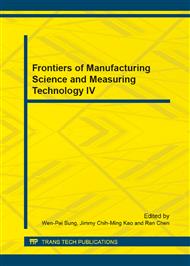[1]
LI Wen-feng, WANG Yong-sheng, YANG Ji-ming, WANG Su, Noise characteristics analysis of aero-engine testing signals, Journal of Aerospace Power. 20 (2005) 900-904.
Google Scholar
[2]
D. L. Donoho, Unconditional Bases are Optimal Bases for Data Compression and for Statistical Estimation, Department of Statistics, Stanford University, Stanford, California, (1993).
DOI: 10.1006/acha.1993.1008
Google Scholar
[3]
KANG Wei-xin, PENG Xi-yuan, The construction and application of wavelet function for pile foundation detection, Electric Machines and Control. 12 (2008) 357-360.
Google Scholar
[4]
Coifman R, Wickerhauser M V, Entropy based algorithms for best basis selection, IEEE Transactions on IT. 38 (1992) 713-718.
DOI: 10.1109/18.119732
Google Scholar
[5]
Donoho D L, De-noising by soft-thresholding, IEEE Transactions on Information Theory. 41(1995)613-627.
DOI: 10.1109/18.382009
Google Scholar
[6]
DONG Y S, Y IX M. Wavelet de-nosing based on four improved function for threshold estimation, Journal of Math. 26 (2006) 473- 477.
Google Scholar
[7]
ZHOU Mi, LI Zun-zun, GENG Guo-hua, Research of image denoising method based on wavelet threshold, Computer Technology and Development. 18 (2008) 22-24.
Google Scholar
[8]
WANG Bing, CHEN Yu, Denoise method of improved threshold for signal excited by embedded piezoelectric sound source, Chinese Journal of Sensors and Actuators. 26 (2013) 1409-1413.
Google Scholar
[9]
ZANG Xian-feng, ZHANG Zheng-dao, Optimal threshold for signal denoising based on wavelet entropy, Journal of Jiangnan University (Natural Science Edition). 8 (2009) 267-270.
Google Scholar
[10]
Zhao Kai, LI Ben-wei, Study on the Evaluation of Engine Performance Based on Hybrid Optimization Algorithm, in: Jinsong Wang, Proceedings of the First Symposium on Aviation Maintenance and Management-Volume II, Northwestern Polytechnical University, Xi'an, 2014, pp.489-497.
DOI: 10.1007/978-3-642-54233-6_54
Google Scholar
[11]
XIAO Fang-yu, TANG Wei, FU Na, Wavelet based de-nosing self-optimizing method, Signal Processing. 28 (2012) 577-586.
Google Scholar
[12]
Wei Fang, Jun Sun, Yanrui Ding, Xiaojun Wu and Wenbo Xu, A Review of Quantum-behaved Particle Swarm Optimization, IETE Technical Review. 27 (2010) 336-348.
DOI: 10.4103/0256-4602.64601
Google Scholar


